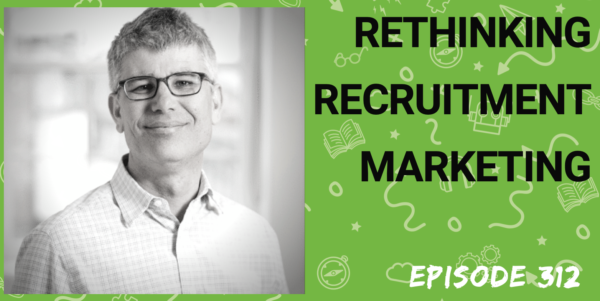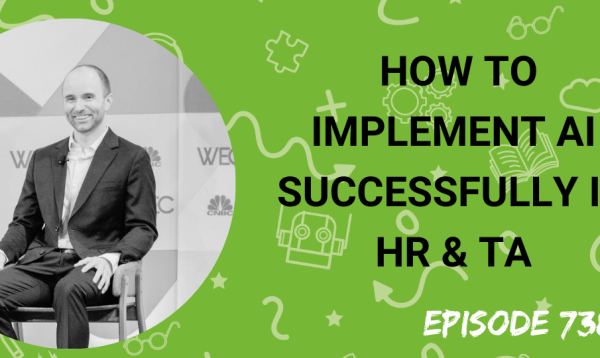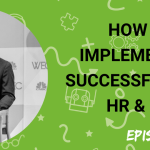In my opinion, one of the most significant changes we are likely to see in Talent Acquisition next year is a rethinking of recruitment marketing. Programmatic advertising, career site systems and a sophisticated foundation of data and analytics are all going to part of this change.
So what should talent acquisition leaders be considering in their recruitment marketing strategies and what changes in talent markets are marketing data currently showing us?
My guest this week is Chris Forman, CEO of Appcast. Appcast has access to a vast dataset that gives them a unique view of global recruitment marketing efficacy, and Chris has some incredibly valuable insights to share.
In our conversation, we discuss:
• Definitions of programmatic advertising
• What is the data telling us about current labour market trends?
• The new focus of the war for talent
• What does effective recruitment marketing look like
• The number one signal of recruitment marketing success
• How employers can increase their application conversion rates
• Short-form and native apply assisted applications.
• Evolving content strategies
• Language, diversity and inclusion
• Authentic, impactful video
• What do the next 18 months have in store for talent acquisition?
Subscribe to this podcast in Apple Podcasts
Transcript:
Matt Alder [00:00:00]:
Support for this podcast comes from Appcast, a leading provider of recruitment advertising technology and managed services. AppCast helps more than 1500 companies find more qualified candidates using advanced programmatic technology and data driven analytics. With Appcast, you’ll effortlessly attract the right talent to your open jobs, helping you save time and money. Find out more about Appcast at Appcast IO. That’s Appcast IO.
Matt Alder [00:00:51]:
Hi everyone, this is Matt Alder. Welcome to episode 312 of the Recruiting podcast. In my opinion, one of the most significant changes we’re likely to see in talent acquisition next year is the rethinking of recruitment marketing. Programmatic advertising, career site systems and a sophisticated foundation of data and analytics are all going to be part of this change. So what should talent acquisition leaders be considering in their recruitment marketing strategies? And what changes in talent markets is the marketing data currently showing us? My guest this week is Chris Forman, CEO of Appcast. Appcast have access to a huge data set that gives them a unique view of global recruitment marketing efficacy. And Chris has some incredibly valuable insights to share. Hi Chris and welcome to the podcast.
Chris Forman [00:01:50]:
Thanks Matt. How are you?
Matt Alder [00:01:52]:
I’m pretty good, thank you. An absolute pleasure to have you on this show. Could you just introduce yourself and tell everyone what you do?
Chris Forman [00:02:00]:
Sure.
Chris Forman [00:02:00]:
My name is Chris Forman. I’m the founder CEO of Appcast.
Chris Forman [00:02:04]:
Appcast is a US based company but.
Chris Forman [00:02:07]:
With operations around the globe and we build programmatic job ad technology software that helps big companies buy and optimize performance job ads more effectively and efficiently.
Chris Forman [00:02:22]:
I’ve been doing recruitment technology for about 20 years.
Chris Forman [00:02:26]:
I’m structurally unemployable. So I have to kind of now start companies so that I have a job. And Appcast is my fourth recruitment technology company.
Matt Alder [00:02:37]:
Fantastic stuff. Before we get too far into the.
Matt Alder [00:02:40]:
Conversation, I’m just thinking it might be.
Matt Alder [00:02:42]:
Good just if you could give everyone a quick explanation as to what programmatic advertising is. Because I know that there is still a lot of people who don’t quite understand the concept.
Chris Forman [00:02:52]:
Oh, 100%. And not only is it some people don’t understand the concept, it’s kind of a warshot test.
Chris Forman [00:02:59]:
You can have a bunch of people.
Chris Forman [00:03:00]:
Understand it through one lens and kind of see the picture and interpret it differently. So understanding that this is a bit.
Chris Forman [00:03:09]:
Of a term of art, this is my definition and it’s really straightforward. So programmatic is a catch all advertising technology term. That fundamentally talks about the use of.
Chris Forman [00:03:24]:
Software and data to optimize ads. This isn’t specific to jobs.
Chris Forman [00:03:30]:
In fact, the programmatic ad revolution kind of came to consumer and B2B ads in search and social display video well before it came to job ads. And there’s lots of different flavors of.
Chris Forman [00:03:46]:
Programmatic technology outside of the job space.
Chris Forman [00:03:49]:
Inside the job space, it pretty much.
Chris Forman [00:03:52]:
Is focused on the use of, of web based software to buy and place.
Chris Forman [00:04:00]:
Pay for performance job ads in the pay for performance job ad ecosystems around the globe. So pay for performance is rather than paying for a job ad that goes up for 30 days and it’s just like a flat rate, kind of the traditional job posting.
Chris Forman [00:04:19]:
You pay whenever somebody looks at your job ad. So that’s oftentimes called cost per click.
Chris Forman [00:04:26]:
When somebody clicks on a job ad, you pay a few pennies. That’s the model that indeed has popularized and indeed is the largest job site globally.
Chris Forman [00:04:38]:
So that’s kind of a big deal.
Chris Forman [00:04:40]:
There’s other models of pay for performance job ads. You can pay per application, in some.
Chris Forman [00:04:45]:
Cases you can even pay per quality.
Chris Forman [00:04:48]:
Application, and there’s a whole bunch of stuff in between.
Chris Forman [00:04:51]:
But fundamentally it’s the use of third party software to buy and place ads.
Chris Forman [00:04:55]:
On job sites where you are paying for an outcome rather than for a duration.
Matt Alder [00:05:01]:
Now, the work that you do means.
Matt Alder [00:05:03]:
That you have access to a lot of data about what’s going on in the market.
Matt Alder [00:05:09]:
How are you seeing the talent markets.
Matt Alder [00:05:13]:
Change sort of through the course of 2020?
Chris Forman [00:05:15]:
Yeah. Oh, it’s a great question, Matt, and.
Chris Forman [00:05:19]:
I am an absolute data nerd. So let’s just talk a little bit about the data set that we have at Appcast, and then I can talk about the kind of macro trends that I’m seeing.
Chris Forman [00:05:30]:
So Appcast has been around since 2014.
Chris Forman [00:05:33]:
And in that time.
Chris Forman [00:05:38]:
About $700 million worth of job advertising has flowed through our system. We’ve bought or optimized 7 1/2 billion.
Chris Forman [00:05:47]:
Job ad clicks and generated over 1.2 billion job applications. So we’re talking about a big data set.
Chris Forman [00:05:57]:
The vast majority of that is in the United States and Canada. So it’s fairly focused in North America. And the platform itself is agnostic.
Chris Forman [00:06:08]:
It works if you want to hire.
Chris Forman [00:06:09]:
Doctors, it works if you want to hire software developers. It works if you want to hire warehouse, you know, kind of workers or truck drivers. And so it’s broad based. It is across, you know, almost every type of applicant tracking system that is commercially available in North America. It’s across every function in every geography. So it’s a, it’s a really fantastic data set. In fact, it’s been used by professors at Harvard Business School and Cornell to, to actually kind of analyze macro trends.
Chris Forman [00:06:43]:
In employment in the.
Chris Forman [00:06:45]:
So we’ve got a data analytics group here at Appcast. And so we’re always kind of looking at what the data tells us. And one of the things that we found is there’s been a transformation in what I call the front in the war for talent. So if you go back to that seminal McKinsey kind of white paper that was published in 1997 called the War for Talent that I think every, you know, executive at a major company in the last 20 years has read, you.
Chris Forman [00:07:17]:
Know, and ironically that was the year.
Chris Forman [00:07:18]:
That I, I joined the industry.
Chris Forman [00:07:21]:
You know, the, the focus of that.
Chris Forman [00:07:24]:
McKinsey white paper was talking about the.
Chris Forman [00:07:27]:
The, the critical need for organizations to find, recruit and retain specialized and high performing talent.
Chris Forman [00:07:38]:
And so in the technology space, the.
Chris Forman [00:07:42]:
Conventional wisdom, software developers, clearly high performing.
Chris Forman [00:07:46]:
Salespeople, executives that know how to make.
Chris Forman [00:07:51]:
Things happen, were the kind of focus of that article.
Chris Forman [00:07:56]:
But if you fast forward to today, what’s super interesting is that the marketplaces, the job ad marketplaces in the United States are now telling us that, that a different type of talent is most.
Chris Forman [00:08:12]:
In demand and that is the E commerce supply chain. So over the course of 2020, clearly.
Chris Forman [00:08:19]:
Impacted by Covid, you’ve started to see.
Chris Forman [00:08:22]:
That what people are willing to pay.
Chris Forman [00:08:25]:
For a technologist or a software developer in Chicago, San Francisco, Austin, New York.
Chris Forman [00:08:33]:
And Boston are being eclipsed by what organizations are willing to pay for warehouse workers in. You know, this is metaphorically, I’m making this up. Peoria, Topeka, you know, the giant fulfillment centers that are at the crossroads of two major highways or delivery drivers that drive the last mile to get boxes to our homes.
Chris Forman [00:09:01]:
In fact, if you take a look.
Chris Forman [00:09:03]:
At the data right now, a click.
Chris Forman [00:09:07]:
For technologists in those areas I talked.
Chris Forman [00:09:10]:
About is anywhere from like $0.40 to.
Chris Forman [00:09:12]:
$3.00, which is pretty robust.
Chris Forman [00:09:16]:
But for warehouse workers, where you’ve seen.
Chris Forman [00:09:19]:
A 300% increase in jobs available for warehouse workers, you’ve also seen a 40% decrease in supply for those jobs because.
Chris Forman [00:09:28]:
A lot of people are kind of opting out of working in those environments due to Covid, there’s also a great deal of competition for these folks. You’re seeing job ad prices on the low end being a dollar okay compared to $0.40 and on the high end up to over $10. So that’s a pretty remarkable shift and one that I think is just speaking.
Chris Forman [00:09:51]:
To the reality and kind of the.
Chris Forman [00:09:54]:
Irony of E commerce is it’s powered by technology.
Chris Forman [00:09:57]:
But still, until the, the, the, the coming wave of robots that I’m sure at some point are going to show.
Chris Forman [00:10:04]:
Up, we still need people to make it work.
Matt Alder [00:10:07]:
That’s really interesting. And is that a pattern you’re seeing.
Matt Alder [00:10:10]:
In other countries all over the world?
Chris Forman [00:10:11]:
Yeah, 100%. The issue is it’s difficult for me to say it as definitively as, as I can in North America and Canada and the United States just because of.
Chris Forman [00:10:21]:
The size of the data set. But, but if we were to look.
Chris Forman [00:10:24]:
At the data sets that we have in EMEA or in apac, they, they are following similar trends.
Chris Forman [00:10:32]:
I just don’t have enough data to prove it.
Matt Alder [00:10:34]:
So I wanted to ask you about.
Matt Alder [00:10:38]:
Sophistication in recruitment marketing because as, as more sort of technology becomes available, the way that we can do recruitment marketing and recruitment marketing strategies obviously needs to change accordingly. What are you seeing in recruitment marketing at the moment?
Matt Alder [00:10:55]:
What’s important?
Matt Alder [00:10:56]:
What’s working?
Chris Forman [00:10:57]:
Yeah. So you know, for, for your listeners, I don’t know if they’re going to.
Chris Forman [00:11:02]:
Love what I have to say because.
Chris Forman [00:11:04]:
It’S not going to be, you know, like some whiz bang piece of tech.
Chris Forman [00:11:09]:
Out there that all of a sudden is the silver bullet that solves all, you know, recruiting problems for everyone. What I’m seeing is, is kind of.
Chris Forman [00:11:15]:
Actually return to some basics.
Chris Forman [00:11:19]:
And the primary trend that I’m seeing is if you go back to the first thing that I said is that.
Chris Forman [00:11:26]:
In certain high volume recruiting markets we’re.
Chris Forman [00:11:30]:
Starting to see the price paid to acquire a job seeker.
Chris Forman [00:11:33]:
Eyeball somebody that’s on your career site, engaging with your job content is increasing materially. Whether you agree with that fact or not.
Chris Forman [00:11:42]:
If you just take it as a fact, you know, we’ll build the logic tree from there.
Chris Forman [00:11:47]:
So job seeker marketing is becoming more expensive. Companies cannot hire a click onto their career site.
Chris Forman [00:11:56]:
So somebody finding the job, clicking on.
Chris Forman [00:11:58]:
It, going to the career site does.
Chris Forman [00:12:00]:
Not an employee make. What an employee makes is an application. You need somebody to throw their hat in the ring.
Chris Forman [00:12:07]:
And so what organizations are finding is that to to again borrow from outside.
Chris Forman [00:12:13]:
Of the job space in the more kind of B2C world is there’s a.
Chris Forman [00:12:20]:
Massive amount of, of shopping cart abandonment in, in the recruitment space. Only about 7% of people that get.
Chris Forman [00:12:30]:
To the, the beginning of an online job application make it to the end of it and you know, if that.
Chris Forman [00:12:39]:
Percentage held true for the e commerce.
Chris Forman [00:12:42]:
Giants that exist in the world right now, Jeff Bezos would be worth a lot less money.
Chris Forman [00:12:47]:
Okay, so what’s the difference between Amazon’s checkout and the checkout that most people have on their. Their job application site is candidly not the tech.
Chris Forman [00:13:00]:
Everyone loves to hate their applicant tracking system. And I feel bad for my friends.
Chris Forman [00:13:04]:
That, you know, build great applicant tracking technology. And a lot of people say, ah.
Chris Forman [00:13:12]:
It’S junkie, it doesn’t work, it’s bad for job seekers.
Chris Forman [00:13:15]:
Actually, the worst thing for job seekers is the number of questions that recruiting.
Chris Forman [00:13:22]:
Organizations put into their applicant tracking system. So we did an analysis at Appcast.
Chris Forman [00:13:28]:
That looked at conversion rate from the time somebody clicks on a job ad to the what percentage of those clicks.
Chris Forman [00:13:37]:
Actually complete an application. And if you have an online application.
Chris Forman [00:13:43]:
That takes less than five minutes to.
Chris Forman [00:13:45]:
Complete, and typically that’s a function of less than 15 questions, you get 385%.
Chris Forman [00:13:52]:
More applications than if you have one.
Chris Forman [00:13:54]:
That takes more than 15 minutes to complete. And so just think about that for a second. That’s across all applicant tracking systems, across.
Chris Forman [00:14:02]:
All devices in general.
Chris Forman [00:14:05]:
And so, yes, there are some applicant.
Chris Forman [00:14:06]:
Tracking systems that are way better at getting a job seeker to kind of throw their hat into the ring. But the number one kind of signal of recruitment marketing success, in my opinion.
Chris Forman [00:14:20]:
For an organization is how long their job application is.
Chris Forman [00:14:24]:
And a lot of organizations have these massive applications because when oftentimes they’ve been built by a committee who has a couple of countervailing interests compared to creating.
Chris Forman [00:14:41]:
A good recruitment marketing process.
Chris Forman [00:14:42]:
The first one is HR wants to get all the information that they need to complete the hire file. And number two is there’s some folks that want to candidly prevent some people from applying. They want to get rid of quote, unquote unqualified applicants. And I would argue that neither of.
Chris Forman [00:15:01]:
Those are great ideas.
Chris Forman [00:15:04]:
First off, if hr, I think, shouldn’t necessarily have a seat at the table.
Chris Forman [00:15:09]:
When it comes to what questions are asked at the initial online application, you can always have somebody that gets a.
Chris Forman [00:15:16]:
Green light from a hiring manager, go.
Chris Forman [00:15:18]:
Back and fill out all the information.
Chris Forman [00:15:19]:
That you need for the background check.
Chris Forman [00:15:21]:
Or for their employee file, you don’t necessarily need to do that upfront, if in fact, the cost of that is getting fewer applicants. And then the second part is, why make an application super long to dissuade.
Chris Forman [00:15:34]:
People from applying so that you only.
Chris Forman [00:15:36]:
Get people that are really interested in applying? I think that’s completely Backwards because the best talent won’t put up with it. Right. They’re just going to be like, ah.
Chris Forman [00:15:45]:
This is too hard.
Chris Forman [00:15:46]:
Somebody else is going to hire me because I’m great and they’re just going.
Chris Forman [00:15:50]:
To abandon the process. Software is really good at sorting through information really efficiently.
Chris Forman [00:15:56]:
What’s the cost of having more people.
Chris Forman [00:15:57]:
Apply for your jobs?
Chris Forman [00:15:59]:
And so, you know, I think that one of the things I’m seeing is.
Chris Forman [00:16:03]:
As the cost per click goes up, more and more organizations are kind of.
Chris Forman [00:16:07]:
Getting back to basics and saying, huh, let’s not look at some whiz bang.
Chris Forman [00:16:11]:
Software or kind of this new razzle dazzle marketing approach. Let’s just make sure we’ve got the basics right and make sure that we.
Chris Forman [00:16:19]:
Don’T have a massive candidate abandonment problem with our online application.
Matt Alder [00:16:23]:
You mentioned 7% as a, as a figure there.
Matt Alder [00:16:26]:
So based on the data you’re seeing, what is achievable? What does good look like in terms.
Matt Alder [00:16:31]:
Of converting interest into an apply?
Chris Forman [00:16:34]:
Yeah, so when companies use a short form, typically, let’s say for a white collar job, that would be contact information, resume, and let’s say two to four knockout questions, something simple you can have.
Chris Forman [00:16:53]:
You know, 20 to 25% application conversion.
Chris Forman [00:16:56]:
Rates if in fact an organization uses.
Chris Forman [00:17:01]:
A native apply assisted technology. And what I mean by native apply is indeed as, I mean that’s called like apply with indeed. And so that allows job seekers to use a button to pre populate an.
Chris Forman [00:17:15]:
Application form with information that they, that.
Chris Forman [00:17:18]:
That they have held on Indeed.
Chris Forman [00:17:19]:
And indeed’s not the only one.
Chris Forman [00:17:21]:
Zip’s got it. LinkedIn has it, you know, Stepstone has it. I mean every major, you know, job site in the world has some of this native applied technology.
Chris Forman [00:17:31]:
With those you can actually get up to 30, 35%.
Matt Alder [00:17:34]:
Fascinating stuff.
Matt Alder [00:17:35]:
And it’s always really interesting to, to hear the data round something that I’ve been talking about for years that a bad candidate experience, something that takes a really long time to do is not an effective talent filter. Because as you say, you know, the very best people just have choices and don’t have time to interface with that.
Matt Alder [00:17:56]:
With that type of process.
Matt Alder [00:17:57]:
And I suppose that takes me on to my next question because one of the biggest aspects of recruitment, marketing and.
Matt Alder [00:18:05]:
Career sites that does influence who applies.
Matt Alder [00:18:07]:
And who doesn’t apply is content. How do you see content developing and content strategies developing?
Chris Forman [00:18:15]:
Yeah, so, so, so there’s a, there’s a couple things. There’s, there’s two ways I want to.
Chris Forman [00:18:20]:
Kind of talk about answering this number.
Chris Forman [00:18:22]:
One is going back to basics.
Chris Forman [00:18:25]:
Language matters.
Chris Forman [00:18:26]:
You know, I, I remember, you know I had this incredible professor at, where.
Chris Forman [00:18:32]:
I went to university at this little.
Chris Forman [00:18:34]:
School in Maine called Colby College and Cedric Bryant.
Chris Forman [00:18:38]:
So Cedric used to play basketball for UCLA, he’s like 6, 10, you know, when I think memory serves. Got his PhD at Oxford and he was my freshman composition teacher.
Chris Forman [00:18:52]:
And you know, he always just to.
Chris Forman [00:18:56]:
Beat into us, you know, words matter.
Chris Forman [00:18:59]:
So again, looking at our data set, one of the things that we found is diversity and inclusion are kind of.
Chris Forman [00:19:06]:
A hot topic right now. And so we boiled the ocean and.
Chris Forman [00:19:10]:
We looked at the role that having.
Chris Forman [00:19:14]:
A gender neutral language in your job.
Chris Forman [00:19:18]:
Ads, what that has compared. When you use a gendered pronoun like you say he or she in a job ad, the result is 70% more.
Chris Forman [00:19:32]:
Applies if you use gender neutral language.
Chris Forman [00:19:35]:
What the data like clearly says is that it is more inclusive and ensures that people feel comfortable throwing their hat in. Now you’re probably saying who puts she.
Chris Forman [00:19:50]:
Or he in a job ad? Well, about 30% of job ads have.
Chris Forman [00:19:53]:
One of those words or a similar word in it. So it’s, you know, it’s kind of a, a simple thing but in terms of, you know, kind of getting people to, to throw their hat into the ring, that’s, that’s, that’s one way to communicate with them. The other way is, you know, to again go against what I’ve just been.
Chris Forman [00:20:15]:
Talking about, which is I don’t have.
Chris Forman [00:20:16]:
A silver bullet or new pieces of.
Chris Forman [00:20:18]:
Technology that can kind of make things better.
Chris Forman [00:20:19]:
There are, there are a couple things that are out in the market right.
Chris Forman [00:20:22]:
Now that I just think are super.
Chris Forman [00:20:24]:
Razzle dazzle and neat and I believe can, can help. One of them is some technology that has finally brought video to, to recruitment.
Chris Forman [00:20:35]:
In an authentic way that I believe is impactful.
Chris Forman [00:20:39]:
So historically when you know, recruiting organizations.
Chris Forman [00:20:43]:
Have a recruiting video, it’s an expensive thing. You hire an ad agency, you got.
Chris Forman [00:20:46]:
A lot of people coming in, you have employees that you know, kind of.
Chris Forman [00:20:49]:
Talk on camera and it’s pretty canned.
Chris Forman [00:20:52]:
That’s not, that’s not how people, that’s not authentic video these days.
Chris Forman [00:20:55]:
Right?
Chris Forman [00:20:55]:
I mean I’m not a social media.
Chris Forman [00:20:58]:
Guy so I have to live vicariously through my children and TikTok and Instagram.
Chris Forman [00:21:05]:
And whatever Facebook and all the videos that are there are, you know, user.
Chris Forman [00:21:12]:
Generated authentic and they’re quick.
Chris Forman [00:21:15]:
And there’s a couple companies out there now. One of them, Ultralabs is super neat out of the United States and they have created a platform that gives recruiting.
Chris Forman [00:21:27]:
Organizations the ability to have employees in.
Chris Forman [00:21:30]:
Their organization create really quick, authentic videos.
Chris Forman [00:21:35]:
Based on prompts so that content can be used to support job ads and.
Chris Forman [00:21:41]:
Support the career site.
Chris Forman [00:21:42]:
Really awesome, neat thing to do. The other thing is there’s technology out there now. It’s been popularized by like Paradox AI.
Chris Forman [00:21:52]:
Out of the United States.
Chris Forman [00:21:54]:
Sonic Jobs in the UK has something similar that uses an interesting ATS integration technology that in essence allows job seekers.
Chris Forman [00:22:05]:
To apply via text.
Chris Forman [00:22:06]:
So it’s a text chatbot that reads the online application and starts feeding questions.
Chris Forman [00:22:12]:
To job seekers so that they can.
Chris Forman [00:22:14]:
Answer those questions via text and in line. And it’s just another way to kind of keep it inclusive and to allow people to interact with your employment brand.
Chris Forman [00:22:25]:
In an authentic way.
Matt Alder [00:22:27]:
So, final question.
Matt Alder [00:22:28]:
I think one of the things that 2020 has showed us is that making predictions about the future is often futile. But I’m going to kind of ask you anyway because I’m interested to get your perspective. What do you see happening in talent acquisition in the next sort of 12 to 18 months?
Chris Forman [00:22:46]:
Well, I think that we’ve gotten some good news in the last week or so about the efficacy of COVID 19 vaccine. What that means to me is that sadly, a lot more people are gonna die and a lot more people are gonna get sick in the short run. But in the medium term, we may be seeing the light at the end of the tunnel.
Chris Forman [00:23:09]:
And the light is not an oncoming train.
Chris Forman [00:23:13]:
I believe that that is going to.
Chris Forman [00:23:16]:
Unleash a tremendous amount of economic activity.
Chris Forman [00:23:20]:
And economic and recruiting always follows economic activity. I also believe that you’re going to see stimulus, you know, kind of macro level stimulus from the developed economies over the next two to three months to kind of keep the economies that are being faced with shutdowns, you know, continuing to operate. That also, I believe is going to have a positive impact on, on at.
Chris Forman [00:23:41]:
Least large organizational hiring.
Chris Forman [00:23:43]:
So I think that we are looking.
Chris Forman [00:23:45]:
At an environment that is going to.
Chris Forman [00:23:51]:
Involve a lot of people getting hired over the next 12 to 24 months. Within that context, I think that, you know, the pandemic has had a lot of, of negative impacts on, on organizations.
Chris Forman [00:24:08]:
And on bottom lines.
Chris Forman [00:24:10]:
So we’re going to be in the classic catch 22 that a lot of talent acquisition professionals know, which is we need a lot of people and you have no money.
Chris Forman [00:24:19]:
So that always constraint drives innovation.
Chris Forman [00:24:24]:
You know, I think that’s an entrepreneur’s creed. Right. And so I think we’re going to be in an environment of, of constraint. And that’s going to force people to start to do the things that we’ve talked about here. Evaluate the stuff that doesn’t cost you.
Chris Forman [00:24:37]:
Any money to fix, like your application.
Chris Forman [00:24:39]:
Process, like the language in, in your job ads.
Chris Forman [00:24:42]:
I also think that it’s going to.
Chris Forman [00:24:43]:
Drive people to, to, to think more critically about how they do spend the money that they spend. And at the risk of sounding somewhat commercial, the use of programmatic technology is exploding right now.
Chris Forman [00:24:58]:
Just exploding.
Chris Forman [00:24:59]:
Like, you know, we’re super lucky as an organization. We continue to grow even in this tough environment. And the reason being is when organizations use programmatic technologies to buy and optimize their job ads, they, their return on investment goes through the roof.
Chris Forman [00:25:17]:
And what that means is they get.
Chris Forman [00:25:19]:
More for the same amount of money or they can spend less to get.
Chris Forman [00:25:21]:
The same amount of outcome.
Chris Forman [00:25:23]:
And both of those things are good in a constraint environment.
Chris Forman [00:25:26]:
So I guess at a particular level.
Chris Forman [00:25:29]:
What I’m going to see is a.
Chris Forman [00:25:30]:
Continued, on the recruitment marketing side, the.
Chris Forman [00:25:33]:
Continuation of this secular shift away from.
Chris Forman [00:25:36]:
People driven ad buying to software driven ad buying.
Matt Alder [00:25:38]:
Chris, thank you very much for talking to me.
Chris Forman [00:25:40]:
Thank you, Matt.
Chris Forman [00:25:41]:
Have a great one.
Matt Alder [00:25:42]:
My thanks to Chris Foreman. You can subscribe to this podcast in Apple Podcasts on Spotify or via your podcasting app of choice. Please also follow us on Instagram. You can find the show by searching for Recruiting Future. You can search through all the past episodes@recruitingfuture.com on that site. You can also subscribe to the mailing list to get the inside track about everything that’s coming up on the show. Thanks very much for listening. I’ll be back next time and I hope you’ll join me.








